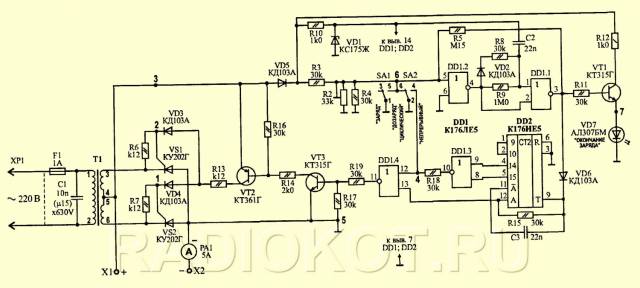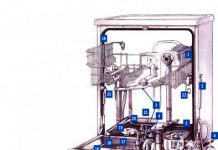In detail: charger cedar auto 4a instructions do-it-yourself repair scheme from a real master for the site my.housecope.com.
Charger Cedar AUTO 4A. Instructions for use
Instructions for use of the prestarting charger Cedar AUTO 4A
The charger Kedr AUTO 4A is intended for charging and restoring the performance of acidic lead 12-volt batteries, partially lost as a result of sulfation and oxidation of electrodes, as well as training them by carrying out charge-discharge cycles in order to increase the resource, service life and preservation.
The device Kedr AUTO 4A provides automatic shutdown at the end of the charge in the "AUTOMATIC" mode. The device has a dial indicator (ammeter) and a light indicator, which: when the "AUTOMATIC" mode is switched on - does not light up; at the end of the charge in the "AUTOMATIC" mode - blinks; when the "CYCLE" mode is turned on, it glows evenly.
The KEDR-AUTO device provides an accelerated mode of charging a completely discharged (up to 10 V) battery with a compromise value of the initial current equal to 3 - 4 A. At the same time, after 1 - 2 hours (depending on the degree of battery discharge and voltage in the network), the value of the charging current decreases to a value of about 2 A and continues to decrease by the end of the charge to 1 A or less. This mode eliminates significant heating of the battery during charging and reduces the charging time of a fully discharged battery to 3 - 6 hours.
Before using the device, you must study the rules for the care and use of batteries.
ATTENTION! Before working with the "Kedr-auto" charger, you must carefully study these operating instructions.
| Video (click to play). |
Be careful! The charger contains life-threatening voltages.
Before replacing the fuse and making repairs, disconnect the charger from the mains.
Do not use a homemade fuse, this may damage the device.
Do not charge batteries near stoves, radiators (at a distance of less than 1 meter).
The ventilation openings in the device case are not allowed.
It is prohibited:
- disassemble the device case and operate the charger with the top cover removed;
- operate the charger if the power cord is damaged;
- operate in conditions of high humidity, as well as in aggressive environments;
- operate the device near open flames or other sources of thermal radiation;
- operate the charger with closed ventilation openings. The battery charging process should be carried out in a well-ventilated area.
Open the cover at the back of the charger and remove the cords. Set the toggle switch for turning on the automation to the "CHARGE" position.
The "CONTINUOUS-CYCLIC" charge mode toggle switch allows you to select the battery charging modes.
If it is necessary to charge the battery, switch the charge mode toggle switch to the "CONTINUOUS" position.
If it is necessary to form or desulfate the plates, when the capacity of the storage battery decreases, switch the toggle switch for selecting the charge mode to "CYCLIC". Connect the load to the terminals of the storage battery (bulb 12V 6 W).
Connect, observing the polarity, the cord using the clamps to the battery.
Electronic protection of the Kedr-M device against short circuit and incorrect polarity connection is designed in such a way that the charging current appears at the output only if a voltage source (battery) with a voltage of at least 10V is connected to the output terminals.
The lamp connected to the terminals of the charger will not light up, since it is not a voltage source.
Switching between the operating modes of the device "CONTINUOUS-CYCLIC" and "CHARGE-FURTHER CHARGE" can be carried out in the process of charging the battery without disconnecting it from the network.
Connect the plug of the 220 V power cord, and the process of charging the battery begins, as evidenced by the ammeter readings.
The charging current of a fully discharged battery at the beginning of charging can amount to 4 A or more, further in the charging process the current will decrease.
When the battery charge is reached, the charger automatically turns off, as evidenced by the glow of the "END OF CHARGE" LED
Switch the toggle switch for turning on the automatics in the "DOUBLE CHARGE" mode and continue charging the battery. The battery is considered fully charged if during the charging process the electrolyte density does not change for two hours.
In cyclic charging mode, after every 45 seconds of charging, the battery is discharged for 15 seconds through the load (light bulb) connected to the battery.
In the “CYCLIC” or “DOUBLE CHARGE” position, the automatic equipment is turned off.
Despite the fact that the charger is simple and reliable in operation, in practice there are cases when consumers, due to improper use, cannot obtain the required charging current and mistakenly consider this to be a malfunction of the charger. These errors are summarized in the table.
Everyone who has a car knows perfectly well where the colored parallelepiped, pasted over with colored stickers, is located, why it is needed, but few people think that the battery is not eternal, and at least it needs to be looked after. Only then will she be able to last the 5-7 years allotted to her. And if necessary, you need to charge it. And to charge correctly, and now there are all the conditions for this.
Hundreds of thousands of models of chargers (chargers), many motorists prefer domestic chargers. Whether it is a genetic force of habit, or a commendable patriotism, the Kedr Auto 4a charger enjoys a certain popularity. Many have difficulties with the repair of this device due to the fact that the circuit has been lost, and it is not always possible to find the original one. We rummaged through our archives, and dug up a diagram of the device, which we offer for study.
It has a simple architecture, and it's pretty easy to figure it out if you can distinguish a resistor from a canister. And if you can't, we will try to explain what it is, why you need it and how to use it.
Chemistry is a delicate thing, and the battery consists of chemical processes through and through. We will not dive into the intricacies of chemistry, but find out what concerns the average motorist, his battery, and the Cedar Auto 4a charger.
The battery should be fine. In winter and summer. But it has an admissible degree of discharge, which is checked quite simply - using a hydrometer, if the design of the battery allows, or by measuring the minimum voltage at the terminals. In the first case, we measure the density, in the second, directly the voltage. The permissible battery discharge value in winter is 25% of the nominal value, and in summer - 50%. If the jar can hold a voltage of 1.6 V for five seconds, then it is fully charged. If the voltage is 1.4 V, then the battery has run out by 50%. all arithmetic.
It is necessary to recharge the battery, and if you chose Kedr Auto 4a, then it will quite cope with its task if it is working properly.And the consequences of improper charging can be frustrating for the battery, so no matter how smart the device is, it needs to be controlled.
Any rechargeable battery is charged from a source that exceeds the battery voltage, and this must be a constant current source. Therefore, the charger must convert the alternating current into direct current, and at the output give us the voltage necessary for charging. The device does this perfectly. Here are its technical data:
- capable of operating from a household network 220 V ± 11 V;
- the nominal voltage of the battery it charges is 12 V;
- minimum charge current - 4.0 A;
- consumes no more than 85 watts.
It is intended both for charging and for restoring batteries that have lost their charge due to a number of reasons. A lot of factors can cause a voltage drop on the battery, but the most important is the sulfation of the plates and their oxidation. Cedar is also intended for educational and training charge-discharge cycles, restoring the battery's ability to hold a charge.
Charging takes place for a certain amount of time, which depends on the battery capacity, on the degree of wear of the plates, as well as on the degree of battery discharge. Equipped with a simple microprocessor that controls all possible modes of charging and operating the device.
When the charger is connected in compliance with the polarity, the device starts charging the battery in automatic mode, which is signaled by the LED. In this mode, the standard battery is charged with a current of no more than 4 A with control of the voltage at the terminals. When the maximum value of the charging voltage is reached, the device disconnects itself from the battery. This is indicated by a flashing LED.
To remove sulfation, you must use the "cycle" mode. In this mode, it is desirable to connect a parallel load to the battery, which consumes about 1 A of current. A 6W car light bulb is suitable for this. If this is not done, then the process will also be successful, but it will take a little longer. To completely eliminate sulfation, it is necessary to leave the battery connected to the device for 3-5 days.
The device also has a pre-start mode for charging the battery. In this case, charging is faster due to the fact that a high current rating is used - up to 10 A. The process takes about five minutes. After that, the device automatically switches to the "automatic" mode, and already limits the current to 4 A.
This is how Kedr Auto 4a works. Thanks to a simple scheme, any malfunction of it can be identified and eliminated, and the device serves for a long time. Keep an eye on the ammeter, and good luck on the road!
The use of reliable chargers is one of the main conditions for the stable and long-term operation of the car battery. The Cedar charger has earned the trust of a large number of users. Easy to operate and multifunctional, this inexpensive automated storage device is in steady demand among experienced drivers and novice motorists.
Characteristics of the charger Kedr-Auto 4A
- Rated voltage of the supply network, V 220
- Nominal voltage of the rechargeable battery, V 12
- Rated power consumption, W 85
Schematic diagram of the automatic control system
Printed circuit board and CAM connection
In more detail, you can read the instructions for it:
If it is not possible to buy it, you can assemble it yourself without any problems. Which I did. The transistors used imported vs556b (pnp) and bc337-40 (npn) instead of kt315 and kt361. The photo shows the factory charger board and my homemade one.
Factory board automatic charger
I assembled this device, checked it - it works fine, I like it. This charger has:
- constant charge mode (up to full capacity)
- protection in case of incorrect connection and short circuit.
- in cyclic mode, after 45 seconds of charge, 15 seconds of discharge follows.
It will be useful to make a small improvement to the memory. Complete disconnection from the 220V network at the end of the charge, so to speak for “every fireman”.Disconnecting the Kedr-M charger from the mains when the LED “end of charging”Can be performed on a triac or relay. The command to turn on / off can be taken from the collector of the VT1 transistor by adding another transistor, turned on in the key mode, and switch it to power the relay winding or the current through the LED of the optocoupler that controls the triac. I collected and checked the scheme: vovcanchin.
The charger is intended for charging and restoring the performance of acidic lead 12-volt batteries, partially lost as a result of sulfation and oxidation of electrodes, as well as training them by conducting charge-discharge cycles in order to increase the resource, service life and preservation.
Before using the device, you must study the rules for the care and use of batteries.
- Rated voltage of the supply network, V - 220 ± 11;
- Rated voltage of the rechargeable battery, V -12;
- Charge current nominal, A, not less - 4.0;
- Power consumption, W, no more - 85.
The front panel contains:
- current indicator for monitoring the charge current;
- button for switching on the "AUTOMATIC" mode;
- LED indicating the end of the charge cycle;
- button for switching on the "CYCLE" mode.
The mains supply cord with a plug and the cords for connecting the device to the battery with clips are removed from the back of the device.
Rice. 1. External view of the charger "Kedr-Auto 4A".
Rice. 2. External view of the charger "Kedr-Auto 12V".
Rice. 3. Schematic diagram of the Kedr-Auto 4A and Kedr-Auto 12V chargers (fuses F2 and F3 are not installed in the Kedr-Auto 12V device).
Tab. 1. List of elements to the schematic diagram of the device "Kedr-4A", "Kedr-12V".
Charger Kedr-auto 4A It is intended for charging and restoring the performance of acidic lead 12-volt batteries, partially lost as a result of sulfation and oxidation of electrodes, as well as their training by conducting charge-discharge cycles in order to increase the resource, service life and preservation.
Before using the device, you must study the rules for the care and use of batteries.
- Rated voltage of the supply network, V - 220 ± 11;
- Rated voltage of the rechargeable battery, V -12;
- Charge current nominal, A, not less - 4.0;
- Power consumption, W, no more - 85.
The front panel contains:
- current indicator for monitoring the charge current;
- button for switching on the "AUTOMATIC" mode;
- LED indicating the end of the charge cycle;
- button for switching on the "CYCLE" mode.
The mains supply cord with a plug and the cords for connecting the device to the battery with clips are removed from the back of the device.
Note: this circuit is similar for the KEDR auto 12V charger, the only difference is that the latter lacks fuses F2, F3.
List of elements to the schematic diagram of the device "Kedr-4A", "Kedr-12V".
Any car owner should have in his arsenal a charger for a 12 V car battery. When operating a car, you simply cannot do without it. If you are a novice car enthusiast and have not yet bought a battery charger, then you will definitely come to this. This is especially important in winter, when the battery needs to be charged more often than usual. Otherwise, you may find yourself in a car with a "dead" battery and you will have to "light up". You can, of course, charge the battery at the service station. But these are unnecessary expenses and wasted time. It's easier to charge the battery in your garage or at home. You just need to choose the right charger. In this article we will talk about chargers for the Cedar car battery. Let's look at different models and read what people say in their reviews.
This charger (charger) is intended for charging car batteries.And also the device is designed to restore the performance of batteries, which they have lost as a result of oxidation and sulfation of electrodes. In addition, the charger can be used for charge-discharge training in order to increase the service life.
Charger "Kedr-M"
- Disabling the charging process in automatic mode;
- There is a cyclic mode of operation (charge-discharge) to restore the lost capacity as a result of sulfation of the plates;
- Protection against incorrect connection of clamps to current leads and short circuit;
- There is a recharge mode designed for a full capacity battery.
The mains cable and cords with clips are located in a special compartment on the back of the device.
Note! ZU "Kedr-M" voltage, which is life-threatening. Always switch off the machine before making repairs or changing the fuse. It is strictly forbidden to use self-made fuses and cover the openings in the case provided for ventilation. In addition, it is forbidden to charge the battery closer than one meter to heaters, stoves, etc.
The table below shows the main parameters of the Kedr-M device.
It is worth noting here that the Kedr-M charger has protection against short-circuit and incorrect connection. The device will work only if a battery with a voltage of 10 volts or more is connected to the terminals. That is, it will not charge a deeply discharged battery, going into defense.
During the operation of the charger, you can switch modes without disconnecting the device from the 220 volt network. If the battery is discharged, then at first the charging current will be 4 amperes, and then it will constantly decrease. After the battery is fully charged, the charger will turn off and the LED will blink, indicating the end of the process. After that you can set "Kedr-M" to recharge mode.
In cyclic mode, the battery is charged for approximately 45 seconds, and then discharged using a connected lamp. In this mode, there is no automatic shutdown and the process must be controlled independently.
Below you can see two variants of the schematic diagram of the charger for Kedr-M car batteries.
Schematic diagram of the Kedr-M charger. Option 1
Schematic diagram of the Kedr-M charger. Option 2
List of circuit diagram elements
The following is a schematic diagram of the circuit board for manufacturing the device.
This charger is designed for charging, recovering lead-acid batteries with a nominal value of 12 volts and conducting training charge-charge cycles.
Power cords and battery connections exit from the back of the device. Unlike the Kedr-M model, there is no compartment for wiring. The procedure for using the Kedr-Auto 4A charger will be shown below in the “How to use?” Section. The table below shows the main characteristics of these models.
Schematic diagram of the Kedr-Auto 4A and Kedr-Auto 12V chargers
In the table you can see a list of elements indicated on the schematic diagram.
List of elements on the schematic diagram of the "Kedr-Auto 4A" and "Kedr-Auto 12V"
The photo below shows a printed circuit board for the manufacture of "Kedr-Auto 4A" and "Kedr-Auto 12V".
Printed circuit board of devices "Kedr-Auto 4A" and "Kedr-Auto 12V"
This is an improved version of the Kedr-Auto 4A charger, which was released in 2008. The manufacturer reports that the charger is designed to charge 12-volt lead-acid batteries.
Charger and pre-starting device "Kedr-Auto-10"
- Improved protection against incorrect connection of terminals, short circuit and overload;
- During the assembly, modern transformers and other components are used;
- Added prestart mode ("afterburner"). In this mode, the battery is charged with a current of 10 amperes. After that, the charger automatically switches to the charging mode with a current of 4 amperes;
- After the end of the main stage of charging, "Kedr-Auto-10" automatically switches the device to recharge with a current of 0.5 ampere. This ensures the most complete charge of the battery and excludes overcharging.;
- The ability to carry out desulfation in a cycle;
- In automatic charge mode, the rated current is 4 A;
- Service life from 5 years, subject to the instructions for use;
- The mass of the charger is only 600 grams;
- Warranty ─ 1 year.
The main characteristics of "Kedr-Auto-10" can be seen below:
- Dimensions are 185 by 130 by 90 millimeters;
- Pre-start mode with charging current up to 10 amperes;
- Rated charging current 4 amps;
- Power consumption is up to 250 watts;
- The rating of the rechargeable battery is 12 volts;
- The charger operates on a 220 volt network.
The charging time depends on the degree of rarefaction of the battery and its capacity. ZU "Kedr-Auto-10" has a microprocessor that controls charging. Including prestarting mode. All this is done when the device is switched to automatic mode. First, an increased charge current is supplied, which is then reduced to the nominal. This speeds up the charging process.
There is nothing complicated in using the charger. Even if you connect the terminals incorrectly, the device will go into protection, and you will not spoil anything.










